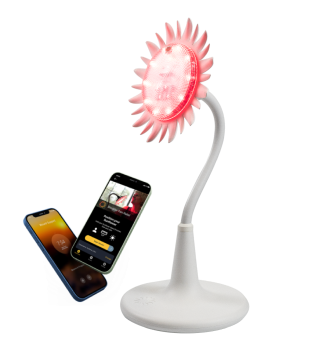
- Shop
- Learn
-
-
- Buy The Sunflower Now
Feel the difference
Get Started with JustLight
Sunflower is the most advanced light therapy available today.

-
- Collaborate
- Blog
- Quiz
- My Account
Free Shipping in the 48 States!
While red light therapy is generally considered safe, there are some concerns about its potential to trigger headaches or migraines.
Buy Sunflower TodayRed light therapy (RLT) has grown in popularity for its numerous health benefits, from improving skin conditions to aiding in muscle recovery. However, like many therapies, it’s important to understand how it can affect different individuals, especially when it comes to sensitive health issues like migraines. While red light therapy is generally considered safe, there are some concerns about its potential to trigger headaches or migraines. Let’s explore whether red light therapy can cause migraines and how it can be effectively used for headache relief.
Red light therapy is typically well-tolerated, but for individuals prone to migraines or headaches, light sensitivity could potentially trigger symptoms. Some people may experience discomfort, stinging, or even mild headaches after red light therapy sessions. This could be due to overstimulation of light-sensitive receptors or improper use of the therapy, such as using it for too long or at too high an intensity.
It’s essential to consult with a healthcare provider if you’re prone to migraines before incorporating red light therapy into your routine. Adjusting the intensity and duration of your therapy can often minimize the risk of adverse effects, such as headaches or itching, which some users experience.
Interestingly, not all light therapies are created equal when it comes to migraine relief. Studies have shown that green light is one of the most soothing light colors for people experiencing migraines. Green light therapy can help reduce the frequency and intensity of migraine attacks, unlike blue or white light, which may exacerbate them.
However, red light therapy has shown promising results for headache relief, especially for tension headaches and migraines caused by inflammation. Red light therapy promotes blood flow and reduces inflammation, which can help ease the pain associated with migraines.
Red light therapy works by using low wavelengths of light (usually between 600 and 800 nm) to penetrate the skin and stimulate cellular processes, including increased production of adenosine triphosphate (ATP). This process can help reduce inflammation and promote healing, which may provide relief from headaches and migraines.
In addition to reducing inflammation, red light therapy can improve blood circulation in the head and neck area, which is beneficial for individuals experiencing migraines due to restricted blood flow. This non-invasive therapy offers an alternative to traditional migraine treatments, such as medication, by addressing the underlying causes of migraines like inflammation and poor blood flow.
To use red light therapy for headaches or migraines, follow these guidelines:
While rare, some users report itching or a stinging sensation after red light therapy sessions. These reactions are usually mild and may be caused by skin sensitivity or overstimulation from the light. If you experience discomfort, reduce the session time or the intensity of the light. Always follow the manufacturer’s guidelines and avoid prolonged exposure if you have sensitive skin.
As mentioned earlier, green light therapy has shown significant benefits for migraine sufferers. Research suggests that exposure to green light may reduce migraine frequency and intensity more effectively than other light colors. However, red light therapy can still be beneficial, especially for headaches caused by inflammation or muscle tension.
Red light therapy is a promising non-invasive option for relieving headaches and migraines by reducing inflammation and improving blood flow. While some users may experience mild side effects like headaches or stinging, adjusting the therapy settings and ensuring proper usage can minimize these issues. Devices like the Sunflower by JustLight offer customizable red light therapy settings, making it easier to tailor treatments to individual needs, especially for those prone to migraines.
If you’re considering red light therapy for headache or migraine relief, consult with your healthcare provider to determine the best treatment plan for your specific needs.
Yes, red light therapy has shown potential to help alleviate migraines by improving blood circulation and reducing inflammation. By targeting the root causes of migraines, such as poor blood flow and inflammation, red light therapy can help provide relief. Devices like the Sunflower by JustLight offer customizable settings to ensure the best results for headache and migraine relief.
While red light therapy is generally safe, some people may experience mild headaches if the intensity is too high or if the session is too long. To avoid this, the Sunflower by JustLight allows you to control session time and intensity, ensuring a comfortable experience and preventing overstimulation that could trigger headaches.
Red light therapy helps reduce migraines by improving blood flow, reducing inflammation, and stimulating cellular activity. This non-invasive therapy promotes relaxation and eases tension in areas prone to headaches, such as the neck and temples. The Sunflower by JustLight offers targeted treatments that can focus on these areas, making it an effective option for managing migraines.
To use red light therapy for migraines, focus the light on areas where you feel tension or pain, such as the forehead, temples, or neck. The Sunflower by JustLight makes it easy with its intuitive app, which customizes your treatment based on your needs, ensuring you get the most out of each session with minimal effort.
The Sunflower by JustLight is a top-tier red light therapy device that stands out due to its adjustable intensity, app-controlled sessions, and scientifically-backed settings tailored for migraine relief. With its ability to target specific areas and provide customized treatments, the Sunflower ensures that your migraines are addressed effectively, giving you a safe and convenient way to manage headaches at home.